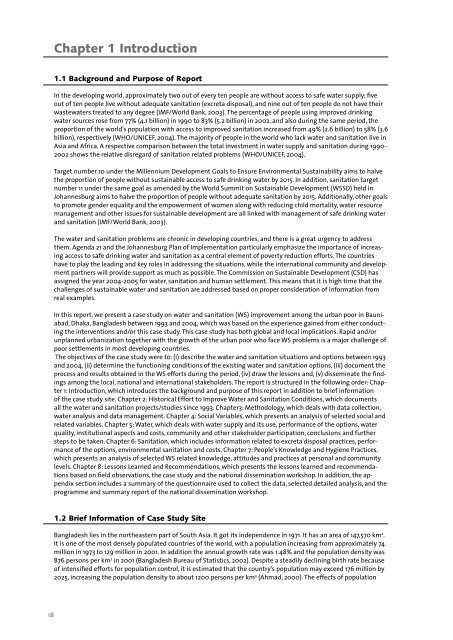Untitled - UNU-IAS - United Nations University
Untitled - UNU-IAS - United Nations University
Untitled - UNU-IAS - United Nations University
You also want an ePaper? Increase the reach of your titles
YUMPU automatically turns print PDFs into web optimized ePapers that Google loves.
Chapter 1 Introduction<br />
1.1 Background and Purpose of Report<br />
In the developing world, approximately two out of every ten people are without access to safe water supply; five<br />
out of ten people live without adequate sanitation (excreta disposal), and nine out of ten people do not have their<br />
wastewaters treated to any degree (IMF/World Bank, 2003). The percentage of people using improved drinking<br />
water sources rose from 77% (4.1 billion) in 1990 to 83% (5.2 billion) in 2002, and also during the same period, the<br />
proportion of the world’s population with access to improved sanitation increased from 49% (2.6 billion) to 58% (3.6<br />
billion), respectively (WHO/UNICEF, 2004). The majority of people in the world who lack water and sanitation live in<br />
Asia and Africa. A respective comparison between the total investment in water supply and sanitation during 1990-<br />
2002 shows the relative disregard of sanitation related problems (WHO/UNICEF, 2004).<br />
Target number 10 under the Millennium Development Goals to Ensure Environmental Sustainability aims to halve<br />
the proportion of people without sustainable access to safe drinking water by 2015. In addition, sanitation target<br />
number 11 under the same goal as amended by the World Summit on Sustainable Development (WSSD) held in<br />
Johannesburg aims to halve the proportion of people without adequate sanitation by 2015. Additionally, other goals<br />
to promote gender equality and the empowerment of women along with reducing child mortality, water resource<br />
management and other issues for sustainable development are all linked with management of safe drinking water<br />
and sanitation (IMF/World Bank, 2003).<br />
The water and sanitation problems are chronic in developing countries, and there is a great urgency to address<br />
them. Agenda 21 and the Johannesburg Plan of Implementation particularly emphasize the importance of increasing<br />
access to safe drinking water and sanitation as a central element of poverty reduction efforts. The countries<br />
have to play the leading and key roles in addressing the situations, while the international community and development<br />
partners will provide support as much as possible. The Commission on Sustainable Development (CSD) has<br />
assigned the year 2004-2005 for water, sanitation and human settlement. This means that it is high time that the<br />
challenges of sustainable water and sanitation are addressed based on proper consideration of information from<br />
real examples.<br />
In this report, we present a case study on water and sanitation (WS) improvement among the urban poor in Bauniabad,<br />
Dhaka, Bangladesh between 1993 and 2004, which was based on the experience gained from either conducting<br />
the interventions and/or this case study. This case study has both global and local implications. Rapid and/or<br />
unplanned urbanization together with the growth of the urban poor who face WS problems is a major challenge of<br />
poor settlements in most developing countries.<br />
The objectives of the case study were to: (i) describe the water and sanitation situations and options between 1993<br />
and 2004, (ii) determine the functioning conditions of the existing water and sanitation options, (iii) document the<br />
process and results obtained in the WS efforts during the period, (iv) draw the lessons and, (v) disseminate the findings<br />
among the local, national and international stakeholders. The report is structured in the following order: Chapter<br />
1: Introduction, which introduces the background and purpose of this report in addition to brief information<br />
of the case study site. Chapter 2: Historical Effort to Improve Water and Sanitation Conditions, which documents<br />
all the water and sanitation projects/studies since 1993. Chapter3: Methodology, which deals with data collection,<br />
water analysis and data management. Chapter 4: Social Variables, which presents an analysis of selected social and<br />
related variables. Chapter 5: Water, which deals with water supply and its use, performance of the options, water<br />
quality, institutional aspects and costs, community and other stakeholder participation, conclusions and further<br />
steps to be taken. Chapter 6: Sanitation, which includes information related to excreta disposal practices, performance<br />
of the options, environmental sanitation and costs. Chapter 7: People’s Knowledge and Hygiene Practices,<br />
which presents an analysis of selected WS related knowledge, attitudes and practices at personal and community<br />
levels. Chapter 8: Lessons Learned and Recommendations, which presents the lessons learned and recommendations<br />
based on field observations, the case study and the national dissemination workshop. In addition, the appendix<br />
section includes a summary of the questionnaire used to collect the data, selected detailed analysis, and the<br />
programme and summary report of the national dissemination workshop.<br />
1.2 Brief Information of Case Study Site<br />
Bangladesh lies in the northeastern part of South Asia. It got its independence in 1971. It has an area of 147,570 km 2 .<br />
It is one of the most densely populated countries of the world, with a population increasing from approximately 74<br />
million in 1973 to 129 million in 2001. In addition the annual growth rate was 1.48% and the population density was<br />
876 persons per km 2 in 2001 (Bangladesh Bureau of Statistics, 2002). Despite a steadily declining birth rate because<br />
of intensified efforts for population control, it is estimated that the country’s population may exceed 176 million by<br />
2025, increasing the population density to about 1200 persons per km 2 (Ahmad, 2000). The effects of population<br />
18
















